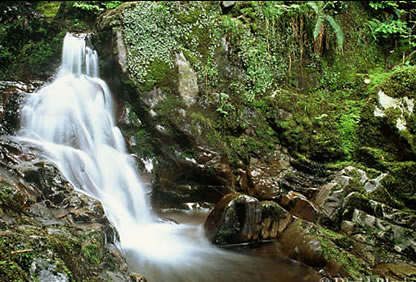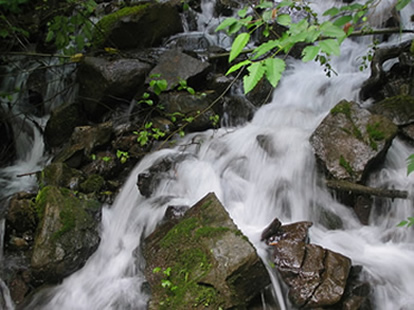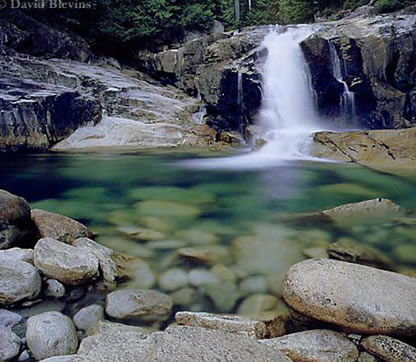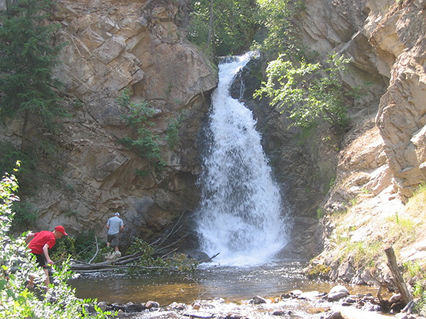

WATERFALLS AND BIODIVERSITY IN BRITISH COLUMBIA

Gwaii Haanas National Park, Queen Charlotte Islands. Photo by David Blevins.
by Trevor Goward and Curtis Bjork
Enlichened Consulting Ltd, Clearwater, BC, Canada V0E 1N0
In 1992, Dr. Wilf Schofield and I (Trevor) began a study of the cryptogams – mosses, hepatics, lichens – that associate with waterfalls in British Columbia . This work has continued off and on over the years – lately without Wilf, who passed away in late 2008 – leading both to a deepening awareness of the ecological importance of such habitats and, latterly, to a growing concern for their continued existence in the province.
The spray zones created by waterfalls are effectively ‘vertical wetlands’ kept cool in summer, mild in winter, and consistently moister than surrounding habitats as a result of constant exposure to atomized water. In our work, Wilf and I soon realized that waterfalls affect the occurrence of bryophytes and lichens far beyond the reach of spray. Presumably this is owing to a continuous outflow of cool air that promotes the establishment of oceanic cryptogams. "Waterfall influence zone" or simply "waterfall zone" would perhaps be more descriptive of the phenomenon as a whole.

Waterfall on Mount Baker, Washington State. Photo by Brian Klinkenberg.
We also quickly realized that not all waterfall zones are created equal, in the sense that some promote rich cryptogam floras, while others do not. Actually this is about what you'd expect given so many potential variations in topography, aspect, associated talus, forest cover, and general habitat heterogeneity. Superimposed over all this, of course, is water chemistry. Even moderate amounts of calcium carbonate suspended in the spray of waterfalls can promote assemblages of cryptogams very different from those associated with streams less rich in nutrient loadings.
Interestingly, this means that knowing what bedrock type underlies a particular waterfall is less important than knowing what bedrock types occur upstream. Also critical here is water temperature, since warmer water holds more nutrients in suspension than colder water. The resulting variation in water chemistry could seem a bit of a nuisance, but for Wilf and me this is precisely what made waterfall inventories so fascinating: predicting which species will or won't turn up is tricky business. A bit like hunting for mushrooms, that way.

Gold Creek Waterfall, Golden Ears Provincial Park. Photo by David Blevins.
Other factors also come to bear. For one thing, waterfalls with strong seasonal variation in stream flow seem much poorer in regionally rare cryptogams than waterfalls that flow at nearly equal volume year round. No less critical, at least in inland regions, is the extent to which a given waterfall freezes over in winter. This is because frozen spray can cover trees and rocks in sheets of ice, and so prevent cryptogams from occupying habitats that would otherwise tend to promote them. By contrast, waterfalls hidden behind a mask of ice in winter produce much less freezing spray; they tend to be associated with healthy lichen communities. Likewise, waterfall zones that have been recently disturbed, e.g., within the past century, are much less likely to support "interesting" cryptogams than their counterparts with much longer environmental continuity.
What is actually known about the biological significance of waterfall zones in British Columbia? Not much, though what little we do know makes clear that we urgently need to know much more. Obviously waterfall zones can be thought of as ecological "petri dishes", that is, tiny islands of habitat conducive to the establishment of species otherwise much more common elsewhere. Effectively they function as range extenders, especially in inland areas, where several macrolichens – for example Anaptychia setifera, Lobaria oregana, Pilophorus clavatus, Pseudocyphellaria crocata, P. mallota -- occur predominantly or even exclusively in the vicinity of waterfalls. For species such as these, the highly localized conditions characteristic of waterfalls zones often promote stable, durable "source populations", thereby sustaining them in regions far outside their main ranges. One wonders to what extent this tendency of waterfalls to create disjunct populations might contribute to genetic variation within certain species.

Sweet Coltsfoot (Petasites frigidus) at edge of falls, Glacier Creek Road, Washington State. Photo by Brian Klinkenberg
Unfortunately, all is not well with British Columbia's waterfalls. The B.C. government projects a greatly increased demand for electricity in the years ahead. In principle, half of this projected increase is supposed to be offset by more efficient use of existing power. As for the other half, the people of B.C. are being granted two options: either we put up with fuel-burning electrical plants, or else we accept a combination of windpower, geothermal power and hydropower. At the moment the favoured option, at least by government, seems to be hydropower, which means we can look forward either to further impoundment of the Peace River by the Site C dam, or else to innumerable creek diversion projects. Or more likely both.
The creek diversion projects – "Run of the river" in government speak – are to be constructed and operated by private firms. These, the independent power producers, or IPPs, prefer to locate their intake dams on portions of creeks where they tumble over steep, rocky ground. While the dams allow some of the water to occupy the stream's original course, the remainder is diverted through a pipe down to the powerhouse. Here diverted water is run through turbines and then returned to the creek. The B.C. government is not wrong to refer to these "run of the river" projects as a renewable energy source; but the degree to which creek diversions are truly 'green' is debatable. By diverting water from creeks, IPPs are certain to diminish the ability of affected waterfalls to support rare bryophytes and lichens. No less disturbing, road construction associated with these developments will give access to some of the province's last remaining low-elevation old-growth rainforests. Can chainsaws be far behind?

Peachland Waterfall, Okanagan Valley. Photo by Brian Klinkenberg
Creek diversion projects are becoming common in many parts of the world. Biologists in other countries – India, New Zealand, Tanzania, the U.K. – have begun to speak out about the threats to biodiversity posed by the loss of waterfall zones. Furthest ahead, perhaps, are the Norwegians, both in the number of creeks now dedicated to hydropower production, and in public outcry over the resulting drawdown on regional biodiversity. Here in British Columbia, we really haven't begun to assess the scope of our own conservation issues around the loss of waterfall zones. Early indications are that we've overlooked a major axis of the province's biological diversity. With more than 100 diversion projects already up and running, and nearly 700 more awaiting government approval, maybe it's time we began to take the implications of all this activity seriously. Wilf Schofield, I feel sure, would heartily approve.
Adapted with permission from Botanical Electronic News No. 404,
February 25, 2009.
Visit the Ways of Enlichenment Website developed by Trevor, Curtis and associates, and learn about their forthcoming book.
LINKS
Click here to view photos of BC waterfalls
Click here to view the Flickr Photo Group: Waterfalls of BC
Click here to view a map of some of the waterfalls of British Columbia
Please cite these pages as:
Author, Date. Page title. In Klinkenberg, Brian. (Editor) 2017. Biodiversity of British Columbia [www.biodiversity.bc.ca]. Lab for Advanced Spatial Analysis, Department of Geography, University of British Columbia, Vancouver.
All material found on this web site is covered by Canadian Copyright Laws. Please contact the respective copyright holder if you wish to use any illustration, photograph or text.